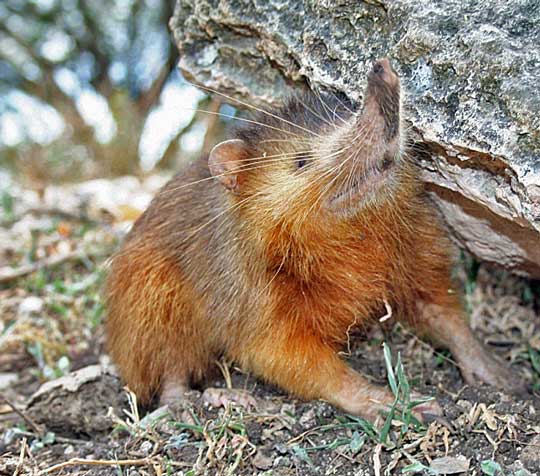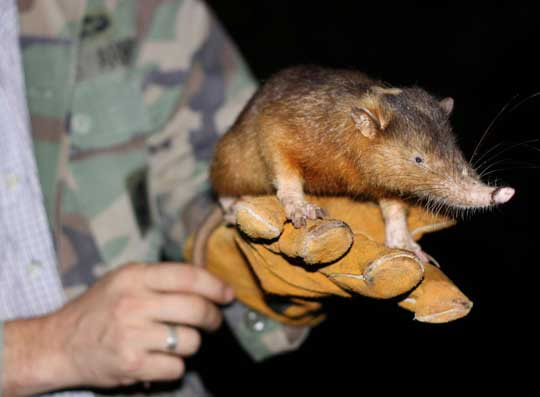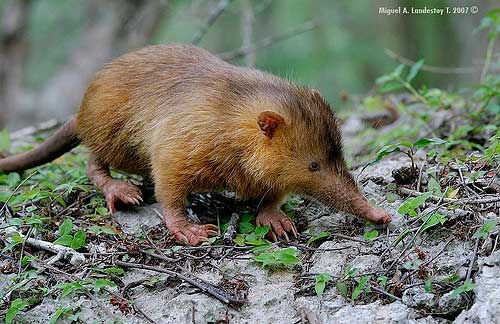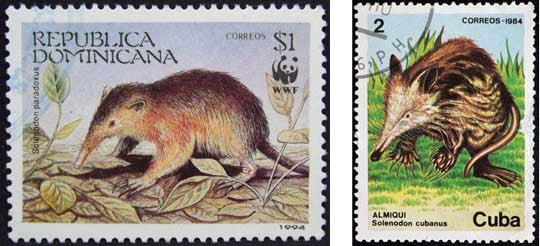|
Thanks to Jay Dell for suggestion this awesome animal. When we think of venomous animals, we usually imagine venomous snakes and spiders. We don 't think of mammals. However, there are a few mammals known to be venomous. The male platypus can inject venom with spurs on its feet. Vampire bats have saliva that prevents clotting and is considered a form of venom. The slow loris has a strange combination of two venoms, one from its legs and one in its saliva, and when mixed together they become even more potent. Hedgehogs can be considered venomous because they intentionally smear toxic substances on their spines, which then get into the bodies of animals trying to attack them. Several species of shrews are definitely venomous—when biting their prey, they can inject venom that gathers in concave pits in their incisors. One type of rare mammal, though, has distinct channels in its teeth that deliver venom when it bites. This mammal is the solenodon. What the heck is a Solenodon? Among the rarest mammals in the world, solenodons are insectivorous, burrowing mammals. Although many species used to live throughout North America 30 million years ago, now only two species remain, the Cuban solenodon and the Hispaniola solenodon. Their closest living relatives are shrews, and although solenodons kind of resemble very large shrews, they are not as closely related as you might think. In fact, these creatures diverged from other mammals (including shrews) about 73 million years ago. Think of it... these animals were around, in about the same form they are today, 7 million years before the massive, astroid-related extinction event that wiped out the dinosaurs (it happened 66 million years ago). DNA analysis has shown that Solenodons split apart from the lineage that eventually became the hedgehogs, moles, and shrews. But that split happened a loooong time ago. Solenodons may slightly resemble shrews in shape, but they are much larger than shrews. They typically are 11 to 13 inches (28 to 32 cm) long (not including the tail) and weigh 1.5. to 2.2 pounds (0.7 to 1 kg). The photo below of a Hispaniolan solenodon gives you an idea of their size. Solenodon venom is not lethal to humans, but notice the handler is still wearing gloves... good idea. Amazing Facts about Solenodons First we need to talk about that venom! Here's how it works. Solenodons have modified, enlarged salivary glands in their mandible (the lower, movable jaw bone). This saliva, which happens to also be the venom, flows through specialized grooves in the lower incisors into the solenodon's prey. So, solenodons are among the very few mammals that actually inject venom, similar to how a venomous snake injects its venom. Solenodons, however, only inject venom through their lower teeth. Recent studies have shown that solenodon saliva (the venom) contains a set of enzymes called kallikreins. These enzymes break down certain proteins, including proteins that help maintain blood pressure. When researchers injected the saliva into mice, their blood pressure immediately dropped drastically. This might be directly fatal to the solenodon's prey, or it would at least make the prey lethargic and easier to kill. Interestingly, some shrews also have kallikreins in their saliva, which also acts as venom. At first thought, you would assume solenodons and shrews got this similar characteristic from a shared ancestor. However, this is not the case, particularly because these groups diverged 73 million years ago. As it turns out, the two groups evolved this venom ability independently of each other... a fascinating example of convergent evolution (when different organisms develop similar traits even though they are isolated from each other). An interesting side note on this—it's possible that solenodons do not have the opportunity to actually use their venom much anymore. Why? Because the venom is most effective on prey animals that are vertebrates, such as rodents, lizards, and birds. Unfortunately, during the last 500 years many of these prey animals have been wiped out in Cuba and Hispaniola (the island that includes Haiti and the Dominican Republic) by humans. Now solenodons are forced to mainly eat insects, which are not affected by the venom in the same way. Sadly, solenodons are adapted to an ecosystem that no longer exists. Check out this video about how solenodons became venomous. Solenodons have supersnouts. Take a closer look above at the creature's nearly hairless snout. You know how some people can (kind of) wiggle their nose? Well, solenodons are really good at this. Their nose is like a highly sensitive finger they can move back and forth. Solenodons, in fact, have a ball-and-socket joint at the base of the nose, kind of like a human shoulder joint, which gives the nose even more movement. This amazingly moveable schnoz helps the solenodon investigate small holes and narrow crevices in search of prey. Solenodons have tiny, poorly developed eyes, and they hunt mostly by smell and touch. Solenodons smell like goats. That's right—goats. Why? Because they have special glands in their armpits and groin that secrete a substance that, well, smells like a goat. Personally, I haven't been around goats enough to know what they smell like, but apparently some people who have handled solenodons do know what goats smell like. Solenodons are rare and difficult to find or study, so very little is known about their habits. They're nocturnal, spending the daylight hours hidden away in burrows or hollow logs. Unfortunately, there are far fewer solenodons than there used to be. When Europeans arrived on the Caribbean islands, they introduced dogs, cats, rats, and mongooses, all of which are threats to solenodons. Human development has also greatly fragmented and reduced the habitat of these creatures. Solenodons give birth to one or two young. If three are born, one will almost certainly die. Why? Because the mother only has two nipples (which, oddly, are situated way back near her rump). If three are born, one will become malnourished and eventually die, allowing the other two to develop normally. One last tidbit of information... solenodons are featured on postage stamps in the Dominican Republic (the Hispaniola solenodon) and in Cuba (the Cuban solenodon). So, the Solenodon deserves a place in the J.D.A.H.O.F. (Jaw-dropping Animal Hall of Fame). FUN FACT: The phrase jaw-dropping first showed up in the Oxford English Dictionary in 1900. It means "causing astonishment or surprise; amazing." This one is pretty easy to figure out, as it is simply a reference to a person’s mouth open wide in amazement or shock. Sometimes it is spelled without a hyphen (jawdropping), but the hyphenated form is most common. There is only one derived form, the adverb jaw-droppingly (as in, "The solenodon has remained unchanged for a jaw-droppingly vast amount of time—73 million years.). So, jaw-dropping is another way to say awesome! Photo Credits:
- Solenodon beside rock - Seb az86556, CC BY-SA 3.0, via Wikimedia Commons - Hispaniolan solenodon held in gloved hand by man - Creative Commons - "Dominican republic-17-025-Joe with solenodon-Credit DWCT" by darwin_initiative is licensed with CC BY-NC-SA 2.0. - Hispaniolan solenodon - Miguel Landestoy - by flickkerphotos is licensed with CC BY-NC-ND 2.0.
0 Comments
Leave a Reply. |
Stan's Cogitations
Everyone needs a creative outlet. That's why I write. Archives
July 2024
|





 RSS Feed
RSS Feed